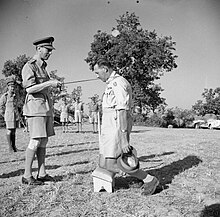Knight
Knight ( English for knight ) is the lowest rank within the nobility in Great Britain , which emerged from the medieval army . The word is etymologically related to “ servant ” and indicates that English knighthood was historically more shaped by the duty of service to the king than the knighthood in continental Europe, which was relatively more privileged. Male knights put the predicate sir ([ sɜː (ɹ) ]) in front of their name , female knights use the predicate lady ([ deɪ̯m ]).
The dignity is conferred exclusively by the British monarch . You either get it through today
- Appointment to Knight Bachelor , or
- Admission to one of the state knightly orders (for single-class orders e.g. as Knight / Dame Companion or in the case of multi-class orders e.g. as Knight / Dame Commander or as Knight / Dame Grand Cross ), see Orders and Medals of the United Kingdom Some state knightly orders of the Commonwealth Realms are also associated with corresponding knighthoods.
For all knights , the investiture is generally carried out by accolade by the British monarch (currently: Queen Elizabeth II ) or by a deputy appointed by him. The name of a female knight is lady , female knights of the Order of the Garter and the Thistle Order are called lady . There is no female equivalent to the Knight Bachelor , this dignity can only be bestowed on men. Female knights can therefore only obtain their title as members of a state knightly order. The dignity of a knight is not hereditary as a personal title of nobility, it must therefore always be acquired by a person and expires with their death.
In the hierarchy of the British nobility , the (hereditary) baronet is superior to the knight ; both together form the gentry . The knights of the state knight orders are superior to the Knights Bachelor.
The dignity of a knight is granted by the monarch as an award for particularly deserving civilians and military personnel. Some orders of knighthood can also include persons who are not citizens of a Commonwealth Realm; in their case, however, unlike subjects of the British crown, this does not lead to an ennoblement . Examples are Bob Geldof or Paul Hewson ( Bono ), both of whom were honored by Queen Elizabeth II as Knight Commander of the Order of the British Empire ( KBE ) because both are Irish and their homeland is not a Commonwealth Realm, but have not been knighted and therefore are not allowed to use the suffix Sir , or the US citizen Norman Schwarzkopf junior , who has been made an honorary Knight Commander of the Order of the Bath ( KCB ). Another illustrative example is Ralf Dahrendorf , who in 1982 was made Knight Commander of the Order of the British Empire (KBE) with German nationality. Only after he had accepted British citizenship by naturalization in 1988 was the accolade made up and he was now allowed to call himself "Sir Ralf Dahrendorf". In 1993, as Baron Dahrendorf , he was raised to life peer status and since then has been addressed as “Lord Dahrendorf” instead of “Sir”.
In the Middle Ages , English knights originally distinguished between two ranks, the higher-ranking bannerets and the lower-ranking bachelors . The Bachelors did not have their own noble vassals and were only in front of their lance as a fighting community in the English army . In the event of war they obeyed a banneret that united their lances into one banner . In the course of time, state knightly orders emerged, whose knights ranked between those of the bannerets and the bachelors. The title of Knight Banneret was only awarded once after the Battle of Dettingen in 1743 in the wake of the declining military importance of the knights after 1642 , and no more after that.
During the Middle Ages there was also the knighthood of a Knights of the Bath , which was awarded with a special initiation ceremony and ranged between the Bachelor and the Banneret. This dignity was last bestowed in 1661.
literature
- William Arthur Shaw: The Knights of England. 2 volumes, Sherratt and Hughes, London 1906.
- Burke's Peerage, Baronetage & Knightage .
Web links
- The Knightage at Debrett’s
